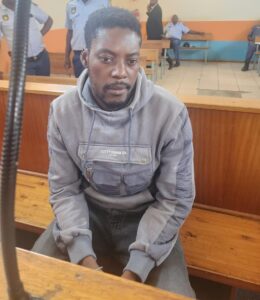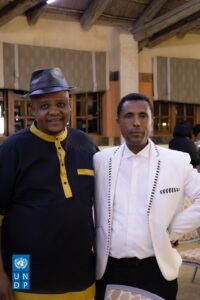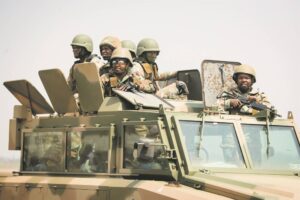And could SADC be making the same mistake it made 11 years ago in the DRC?
By Silence Charumbira
MASERU. Lesotho – The South African National Defence Force (SANDF), which is part of the Southern African Development Community Mission in the Democratic Republic of Congo (SAMIDRC) incurred its first casualties last week after the death of two soldiers while three others were injured in a mortar bomb attack.
Commentators have said South Africa’s involvement in this peacekeeping exercise seems to be motivated by the desire to preserve the first family’s mining interests in the Goma area. Critics say SANDF has never been in DRC to protect the Congolese nor to fight rebel groups like the M23. Instead, this is a hatchet job that is fighting groups of Congolese citizens, the critics say. Others even go on to say the troops were deployed to protect mines “so that Cyril Ramaphosa and his cronies can plunder minerals in the east of the country with ease,” an unnamed South African legislator is quoted to have said in the media. But then these allegations are untested. And they must be tested.
Rebels were defeated in DRC before
Added to that, SADC seems to be making the same mistake it made in a similar situation 11 years ago when it hurriedly deployed with no definitive plan for a lasting solution. At the time, the rebels were defeated, and they moved to other regions but returned three years ago. This is tantamount to treating the symptoms and ignoring the problem. What is prudent is resolving the grievances of the M23 rebels and start affording the Congolese Tutsis, whose cause M23 are fighting for.
SANDF on Thursday confirmed that a mortar bomb landed inside one of the South African Contingent’s military bases on Wednesday. As a result of this indirect fire, the SANDF suffered two fatalities and three members sustained injuries. SANDF is part of the Southern African Development Community (SADC) Mission to the Democratic Republic of Congo (SAMIDRC) which started deploying in December 2023. The mission is reportedly assisting the Congolese government in restoring peace and security in the eastern part of the country.
While addressing the deployment, Congolese Minister of Foreign Affairs Christophe Lutundula said, “the main objective of the SADC force is defeating the M23 rebellion”.
What is the role of the peace keepers in the DRC?
Prior to their deployment, the Southern regional bloc had claimed that it would work with the Congolese army to combat all negative armed groups in eastern DRC. Yet, with the Congolese government help, the force’s primary mission has shifted to attacking the M23 rebels only.

That South Africa has suffered losses this early into the mission is unfortunate, but the question remains, is Pretoria ready to take such losses? Peacekeeping missions are crucial because they are the most practical way of attaining stability for any territory but is South Africa’s involvement sincere? Some may remember that, South Africa’s neighbour, up north, across the Limpopo River, Zimbabwe, was in 1998 involved in peacekeeping missions in the DRC. That involvement too was shrouded in controversy with critics and opposition claiming that the then president, Robert Mugabe’s interest was looting of diamonds in the mineral rich DRC. The allegations were never proven but at the time, it was reported that Zimbabwe deployed up to 10 000 troops in DRC at a cost of about US $3 million a month. While South Africa currently has about 3 000 boots on the ground, which is less than that of Zimbabwe in the 90s, the cost is not mean. Whatever South Africa spends in the DRC must be justified through a systematic and well-thought out and well-coordinated approach.

Read more news from Africa News 24
SA President Ramaphosa announces 2024 general elections date
Here is why the approach must be well thought out and well-coordinated. In 2013, the Force Intervention Brigade (FIB) from the SADC region, comprising of troops from Malawi, Tanzania, and South Africa, defeated the M23. The group then fled to Rwanda and Uganda, but it resumed fighting in late 2021.
Eleven years ago, SADC defeated the rebel group, but it still came back. Who are these rebels that the SADC are fighting? And why are the rebels fighting again?
Who are the M23 rebels in the DRC?
The M23 or “March 23 Movement” is a Congolese rebel group, founded in 2012. The rebel group is fighting for many grievances which have not been solved by their government. One of them is the continued harassment, persecution, and killing of the Kinyarwanda speaking community, especially Congolese Tutsi.
Unlike other militia, the M23 is a rebellion fighting against their government that has deprived its communities, the Congolese Tutsi, of the right to citizenship, for decades.
To date, Congolese Tutsi and Rwandophones are being killed and, this has reached a Genocide stage. The only protection they get is from the M23 rebels.
The government in Kinshasa, and previous regimes, deliberately refused to recognize that the rebels are legitimate Congolese citizens. Whenever there is a political crisis, Kinshasa claims that these people are Rwandans simply because they speak the same language as the people of Rwanda.

The M23 rebels are fighting an existential threat, the FDLR, a Rwandan genocidal militia, formed by remnants of the criminals that perpetrated the 1994 Genocide against the Tutsi in Rwanda.
For nearly three decades, this Rwandan genocidal militia has spread its deadly genocide ideology in the region. As a result, this has prompted Congolese government officials, army officers, and ordinary citizens, to harass, kill and brand Congolese Tutsi as ‘foreigners’, another problem that Africa as a whole must rid itself of.
This insecurity situation in east DRC has led to an influx of refugees. By February 2023, the UN Refugee Agency reported more than one million Congolese refugees and asylum-seekers in countries bordering DRC, with nearly half of them, 479,400, sheltered in Uganda. Another 87,500 are scattered in Burundi, 80,000 in Tanzania, and elsewhere.
Most of these refugees are Kinyarwanda speaking Congolese, especially the Tutsi. Some of them have spent more than 20 years in refugee camps, and wish nothing more than to return home and live peacefully in their home country.
The Congolese government has failed to solve any of these grievances, prompting the M23 rebels to take up arms and fight.
Deployment of SADC in the DRC
On the other side, Kinshasa has decided to dismiss the claims of the rebel group, branded them as terrorists, and claims that the group is being supported by Rwanda. An allegation Kigali has vehemently denied.
With dialogue being out of the way, the Congolese government has decided to fight the M23 rebels militarily, with the help of SADC.
With the help of the Congolese national army, the SADC force’s primary mission is fighting the M23 rebels only, completely disregarding the other armed groups exceeding 260, operating in eastern DRC, and committing atrocities against civilians daily.
Fighting the M23 without addressing the root causes of their fight against their government is only escalating instability and violence. The deployment of South African forces shows that SADC is not in DRC looking for peace.
The M23 rebellion is a Congolese internal problem, working to make sure their government listens and meets their needs. The SADC is only fighting Congolese citizens, fueling more violence.
The Southern bloc should genuinely examine why the group is taking up arms again after all this time and understand why the group is still willing to fight even after their defeat more than a decade later.
It is important for the Southern African Development Community (SADC) to learn from past mistakes and ensure a comprehensive and lasting solution to the current situation. Simply deploying troops without addressing the underlying grievances and causes of conflict will only lead to a temporary resolution.

To effectively address the issue, SADC should focus on resolving the grievances of the M23 rebels. This could involve engaging in dialogue and negotiations to understand their concerns and find a peaceful resolution. By addressing the root causes of the conflict, such as political marginalisation or ethnic tensions, SADC can work towards a more sustainable solution.
Additionally, it is crucial to address the concerns of the Congolese Tutsis, whose cause the M23 rebels are fighting for. This could involve ensuring their rights and representation within the political system, promoting inclusivity, and addressing any discrimination or marginalisation they may face. By addressing these grievances, SADC can help create a more inclusive and stable environment in the region.
Ultimately, the focus should be on finding a lasting solution rather than simply treating the symptoms of the conflict. By addressing the underlying causes and resolving grievances, SADC can contribute to long-term peace and stability in the region. And if any country contributes its troops to the peacekeeping mission in the DRC, then the move must be well coordinated otherwise the losses will be huge both financially and also in terms of human lives.
Silence Charumbira is a Lesotho-based journalist who has written extensively for various international publications including The Guardian and CNN. He is a past deputy editor of the Lesotho Times and Sunday Express newspapers in Lesotho. He can be reached on sekecharu@gmail.com. He writes here in his personal capacity.












